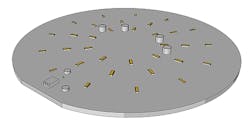Zhaga approves Books 14 and 16 for LED light engines, appoints test labs
Books for linear and circular LED light engines can now be used by Zhaga members in SSL luminaire designs, while Zhaga has formally approved test labs for Book 14 linear products.
The Zhaga Consortium has announced that two new books defining LED light engines (LLEs) have been approved for use by consortium members in solid-state lighting (SSL) luminaires. The new Book 14 defines flat rectangular LLEs for linear fixtures while Book 16 defines flat circular LEDs for round ceiling fixtures. Meanwhile, the consortium also announced that test labs Dekra, Intertek, and VDE have been approved to test Book 14 LLE designs to ensure interoperability with luminaires designed to the specification and interchangeability between LLEs from different vendors.
Interested in articles & announcements on LED & SSL standards?
Zhaga is an SSL industry organization chartered with developing standards for LLEs and associated technologies that can help luminaire makers simplify their supply chain and reduce production costs through a modular approach to luminaire design. The organization has developed more than ten specifications that are promulgated in what the consortium calls Books, supporting a wide variety of different indoor and outdoor applications. Moreover, the Books define LLEs both with and without integrated driver electronics or what the consortium calls electronic control gear, and also both socketable LLEs or those that require tools for attachment.
Linear luminaires
The Book 14 specification for linear products includes options for three different categories or lengths of LLEs — 565, 1166, and 1466 mm. The concept for Book 14 luminaires is not dissimilar to the ubiquitous fluorescent linear troffer. The specification defines a socketable design that means the LLE can be installed or removed from the luminaire without a tool. The Book 14 LLEs will not be circular like fluorescent tubes but will nonetheless install much like tubes.
Book 14 also specifies that the LLE have an integrated driver. That element is different from a fluorescent tube in that the luminaire typically houses the ballast in the traditional troffer example. Book 14 does not define characteristics such as optical beam pattern, but LLE manufacturers are required to disclose such characteristics in detail.
Circular luminaires
The Book 16 specification is very similar in generic characteristics to Book 14. Again, the LLE is required to have an integrated driver, meaning that the LLE is connected directly to AC or mains power. The specification is intended for use in low-profile, low-glare circular luminaires in what Zhaga terms "low-luminance" applications.
The Zhaga Book 16 specification defines flat circular LED light engines for round ceiling fixtures.
There are a greater number of categories in Book 16 relative to Book 14, meaning more flexibility in luminaire size or in this case diameter. The choices include 130, 180, 250, 350, and 500 mm. The specification also strictly defines mounting holes. But Book 16 will require tools for installation or removal of the LLE unlike in Book 14.
Spec availability and test
For now, the new Books are only available for download and use by Zhaga members. But the organization typically transitions the Books into the open domain with maturity and once Zhaga members announce products and the initial interoperability testing is complete. It was back in 2012 that Zhaga first made a Book publicly accessible.
Clearly the testing of Book 14 products will ensue shortly with appointments of the test labs. The test labs provide third-party validation that products meet all electrical, thermal, optical, and mechanical elements of a Book. Approved products go in the Zhaga Certified Products Database and are easily located on the organization's website.

Maury Wright | Editor in Chief
Maury Wright is an electronics engineer turned technology journalist, who has focused specifically on the LED & Lighting industry for the past decade. Wright first wrote for LEDs Magazine as a contractor in 2010, and took over as Editor-in-Chief in 2012. He has broad experience in technology areas ranging from microprocessors to digital media to wireless networks that he gained over 30 years in the trade press. Wright has experience running global editorial operations, such as during his tenure as worldwide editorial director of EDN Magazine, and has been instrumental in launching publication websites going back to the earliest days of the Internet. Wright has won numerous industry awards, including multiple ASBPE national awards for B2B journalism excellence, and has received finalist recognition for LEDs Magazine in the FOLIO Eddie Awards. He received a BS in electrical engineering from Auburn University.





![The DesignLights Consortium continues to make progress in shifting outdoor lighting products and implementation practices toward a more restrained and thoughtful strategy. [Image does not represent a DLC qualified fixture.] The DesignLights Consortium continues to make progress in shifting outdoor lighting products and implementation practices toward a more restrained and thoughtful strategy. [Image does not represent a DLC qualified fixture.]](https://img.ledsmagazine.com/files/base/ebm/leds/image/2024/08/66be810888ae93f656446f61-dreamstime_m_265700653.png?auto=format,compress&fit=&q=45&h=139&height=139&w=250&width=250)